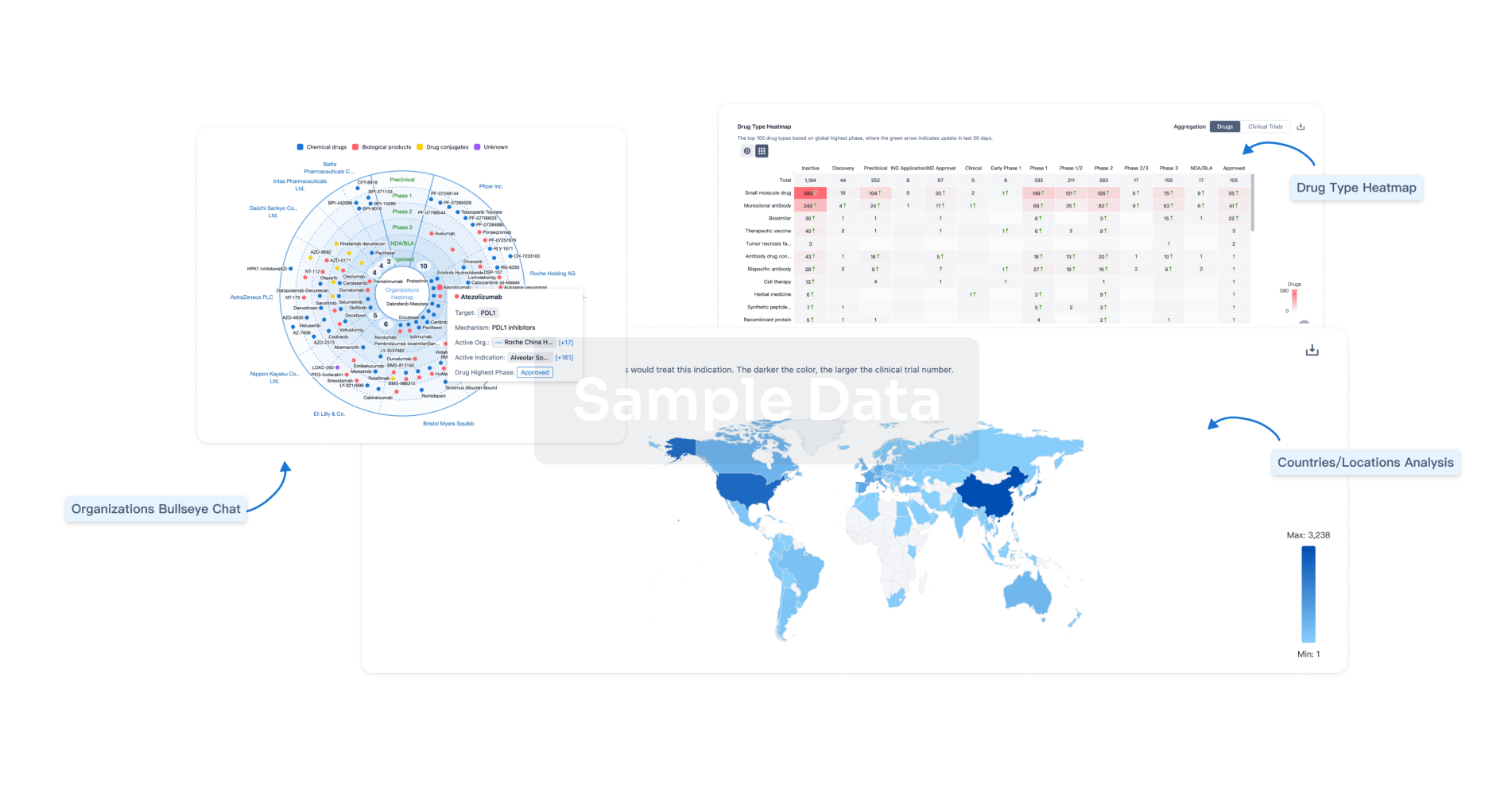Request Demo
Last update 08 May 2025
Thymic Aplasia
Last update 08 May 2025
Basic Info
Synonyms Absent thymus, Agenesis of thymus, Agenesis of thymus (disorder) + [26] |
Introduction Absence of the thymus. This feature may be appreciated by the lack of a thymic shadow upon radiographic examination. [https://orcid.org/0000-0002-0736-9199] |
Related
2
Drugs associated with Thymic AplasiaTarget- |
Mechanism Tissue replacements |
Active Org. |
Originator Org. |
Active Indication |
Inactive Indication |
Drug Highest PhaseApproved |
First Approval Ctry. / Loc. United States |
First Approval Date08 Oct 2021 |
Target |
Mechanism FOXN1 modulators |
Active Org. |
Originator Org. |
Active Indication |
Inactive Indication- |
Drug Highest PhasePreclinical |
First Approval Ctry. / Loc.- |
First Approval Date20 Jan 1800 |
2
Clinical Trials associated with Thymic AplasiaNCT05329935
Congenital Athymia Patient Registry of RETHYMIC
This Congenital Athymia Patient Registry is an observational exposure-based registry study. It uses a prospective cohort design to follow patients who have been treated with RETHYMIC.
Clinical studies conducted with investigational RETHYMIC showed that treatment can result in immune reconstitution and prolong life. This treatment-based registry is being conducted to learn more about the reconstitution process following treatment and the impact of treatment on longer-term survival and the occurrence of adverse events of special interest (AESI).
Clinical studies conducted with investigational RETHYMIC showed that treatment can result in immune reconstitution and prolong life. This treatment-based registry is being conducted to learn more about the reconstitution process following treatment and the impact of treatment on longer-term survival and the occurrence of adverse events of special interest (AESI).
Start Date25 May 2022 |
Sponsor / Collaborator |
NCT02274662
Expanded Access Protocol Thymus Transplantation for Immunodeficiency, Hematologic Malignancies, and Autoimmune Disease Related to Poor Thymic Function
The primary purpose is to provide access for patients who have immunodeficiency or severe autoimmune disease related to poor thymic function to cultured thymus tissue for implantation. With no thymus function, bone marrow stem cells do not develop into educated T cells, which fight infection.
Eligible participants receive cultured thymus tissue for implantation and may undergo biopsy. Immune suppression may be given depending on the immune status and clinical condition of the participant. Immune function testing is continued for one year post-implantation.
Eligible participants receive cultured thymus tissue for implantation and may undergo biopsy. Immune suppression may be given depending on the immune status and clinical condition of the participant. Immune function testing is continued for one year post-implantation.
Start Date01 Aug 2014 |
Sponsor / Collaborator |
100 Clinical Results associated with Thymic Aplasia
Login to view more data
100 Translational Medicine associated with Thymic Aplasia
Login to view more data
0 Patents (Medical) associated with Thymic Aplasia
Login to view more data
476
Literatures (Medical) associated with Thymic Aplasia01 May 2025·Clinical Immunology
Ex vivo T-lymphopoiesis assays assisting corrective treatment choice for genetically undefined T-lymphocytopenia
Article
Author: Gennery, Andrew R ; Sebire, Neil ; Boztug, Kaan ; Marzollo, Antonio ; André, Isabelle ; Rai, Rajeev ; Golwala, Zainab M ; Evans, Grace ; De Braem, Victoria Bordon Cueto ; Sellmer, Anna ; Lizot, Sabrina ; Holm, Mette ; Obiri-Yeboa, Irene ; Nademi, Zohreh ; Garrigue, Alexandrine ; Kusters, Maaike A ; Buckland, Matthew ; Hackett, Scott ; Kreins, Alexandra Y ; Thrasher, Adrian J ; Ocampo-Godinez, Juan Moises ; Worth, Austen ; Adams, Stuart ; Torpiano, Paul ; Soler-Palacin, Pere ; Nierkens, Stefan ; Davies, E Graham ; Pichler, Herbert ; Klocperk, Adam ; Schmid, Jana Pachlopnik ; Corredera, Marta Martin ; Goncalves, Helena Spiridou ; Marcus, Nufar ; Gilmour, Kimberly ; Awuah, Arnold ; Howley, Evey ; van Montfrans, Joris ; Moirangthem, Ranjita Devi ; Soomann, Maarja ; Bernard, Fanette ; de Koning, Coco ; Kricke, Susanne ; Cole, Theresa ; Hambleton, Sophie
01 May 2025·Journal of Allergy and Clinical Immunology: Global
Coexistence of coloboma, heart defects, atresia choanae, growth retardation, genital abnormalities, and ear anomalies (CHARGE) syndrome and heterotaxy in a newborn with athymia
Article
Author: Braddock, Stephen R ; Knutsen, Alan ; Patil, Rica ; Hunter, Jacquelyn
01 Feb 2025·Journal of Allergy and Clinical Immunology
Adulthood outcomes of thymic transplantation in a case of congenital athymia due to FOXN1 mutation
Article
Author: Almeida, Afonso R M ; Sousa, Ana E ; Santos, Diana F ; Silva, Susana L ; Paulo-Pedro, Margarida ; Gomes, André M C ; Marques, José G ; Moleirinho, Beatriz ; Rei, Margarida
22
News (Medical) associated with Thymic Aplasia01 Oct 2024
October 2024 – Genewity is proud to announce that earlier this year, i-Thymus has been granted Orphan Drug Designation by both the European Medicines Agency (EMA) and the U.S. Food and Drug Administration (FDA) for the treatment of congenital athymia. This recognition from both regulatory bodies marks an important milestone for the development of i-Thymus and highlights its potential to address a critical unmet medical need.
Acceleration forGenewity
The Orphan Drug Designation brings several key benefits that will accelerate the development of i-Thymus. Most significantly, it grants market exclusivity for up to ten years in Europe and seven years in the U.S. following approval, ensuring a strong competitive position in both markets. Genewity will also gain financial incentives, including reduced regulatory fees in the EU and tax credits for clinical trials in the U.S., which will help lower development costs and extend the company's resources.
In addition, both the EMA and FDA offer regulatory support to companies developing orphan drugs. This includes personalised guidance on clinical trial design and the overall regulatory pathway, reducing risks and increasing the likelihood of approval. This support will be critical as Genewity advances i-Thymus toward manufacturing under Good Manufacturing Practices (GMP) and investigations at clinical stage.
Acceleration for patients with congenital athymia
Congenital athymia, as seen in patients with complete DiGeorge syndrome, currently has limited treatments available. One, for example, is used in the U.S. but depends on the availability of donor tissue, which limits its accessibility and effectiveness for many patients. Genewity’s i-Thymus is designed to tackle the underlying cause of the disease at a genetic level with an autologous and potentially curative approach. By modifying a patient’s own cells to create functional autologous thymus tissue, i-Thymus could bring a transformative therapy to patients who urgently need it, providing them with a chance to develop a functioning immune system and significantly improving their quality of life.
What is next for Genewity
“Securing orphan designation in both Europe and the U.S. is a huge achievement for our small, ambitious team,” said Dr. Arno Bisschop, CEO of Genewity. “This validation strengthens our confidence in the potential of i-Thymus to make a real difference in the lives of patients without a functioning thymus. We are eager to move forward and take the next steps toward clinical development.”
With the Orphan Drug Designations in place, Genewity will be able to advance i-Thymus more quickly towards the clinic. Having the support of the EMA and FDA, i-Thymus is optimally positioned to create significant value for patients.
About Genewity
Genewity Holding B.V. is a biotechnology company based at the Leiden Bioscience Park, Netherlands, specialising in the development of advanced treatments using extracorporeal gene therapy with lentiviral vectors. This technology enables the modificationof stem cell characteristics, opening new avenues for innovative gene-modified cell therapies. The company focuses on generating thymus cells from pluripotent stem cells to develop treatments for congenital athymia and autoimmune diseases.
Orphan DrugGene Therapy
02 Mar 2023
Stan Wang, M.D., Ph.D., founder and CEO, Thymmune
Thymmune is backed by an A-list team of investors including Pillar VC, former Alnylam CEO John Maraganore and famed geneticist George Church.
Stan Wang, M.D., Ph.D., founder and CEO, Thymmune Therapeutics/company courtesy
Famed geneticist George Church has spun out another company – this one developing cell therapies that regenerate the thymus, thereby restoring and improving immune function.
Thymmune Therapeutics
debuted
Wednesday with
$7 million in seed financing
.
The Mass.-located start-up is backed by Boston-based venture capital firm Pillar VC, which led the financing round. Several other institutional and personal investors participated, including the New York Blood Center’s NYBC Ventures, former Alnylam CEO John Maraganore and Church.
Founded in 2019, Thymmune is built on decades of research on the thymus gland, Stan Wang, M.D., Ph.D., founder and CEO, said in a statement. Wang was a member of Church’s lab at the Harvard Medical School from 2016 to 2018.
“Historically, the thymus was thought to be a vestigial organ but recent decades of research have shown it to be critical in proper immune function,” Wang told
BioSpace.
Thymmune’s goal is to combine this growing body of thymus knowledge with the recent advancements in cell therapies.
Joining Wang at Thymmune’s masthead is chief scientific officer Bing Lim, M.D., Ph.D., who has held leadership positions at Sana Biotechnology, Merck and Singapore’s A*STAR. The start-up has six other employees fulfilling various scientific research functions.
In 2021, Thymmune established its base of operations in Kendall Square in Cambridge. The same year, it won five Golden Tickets – a record in the Boston area – from big sponsors: Pfizer, Novo Nordisk, LG Chem Life Sciences, Boehringer Ingelheim and Astellas. Tickets are awarded to promising early-stage life-sciences start-ups.
Targeting the Thymus
The thymus gland is a small organ tucked beneath the breastbone. Its primary function is to produce T cells, which help the body ward off infections and diseases and mount an immune response to vaccines. The thymus grows weaker with age and is less capable of producing naïve T cells, leading to immune dysfunction and various chronic conditions.
Thymmune aims to reverse this process by combining machine learning with cellular engineering to mass produce thymic cells derived from induced pluripotent stem cells. With this approach, the start-up intends to create off-the-shelf cell therapies that can restore immune function minimally invasively.
“Our approach has the potential to transform immunology by developing novel therapies for patients with a range of immune system disorders,” Wang said in a prepared statement.
The small team will first test their platform against athymia, a rare and congenital immune disorder wherein an infant is born without a thymus. Babies with athymia cannot produce T cells and are at a high risk of infection. Left untreated, athymic infants typically die by age two or three.
The company is also looking at testing its platform to treat several autoimmune diseases and address organ transplant tolerance, Wang told
BioSpace
.
In the future, Thomas de Vlaam, Principal, Pillar VC, said Thymmune’s platform could also boost immune function and address the biology of aging.
Thymmune joins the cadre of biotech start-ups that have spun out from Church’s lab at Harvard. This includes de-extinction company
Colossal Biosciences
, protein barcoding start-up
Manifold Bio
and aging-focused firm
Rejuvenate Bio
.
Cell TherapyImmunotherapy
02 Mar 2023
Stan Wang, M.D., Ph.D., founder and CEO, Thymmune Therapeutics/company courtesy
Famed geneticist George Church has spun out another company – this one developing cell therapies that regenerate the thymus, thereby restoring and improving immune function.
Thymmune Therapeutics debuted Wednesday with $7 million in seed financing.
The Mass.-based start-up is backed by Boston-based venture capital firm Pillar VC, which led the financing round. Several other institutional and personal investors participated, including the New York Blood Center’s NYBC Ventures, former Alnylam CEO John Maraganore and Church.
Founded in 2019, Thymmune is built on decades of research on the thymus gland, Stan Wang, M.D., Ph.D., founder and CEO, said in a statement. Wang was a member of Church’s lab at the Harvard Medical School from 2016 to 2018.
Joining Wang at Thymmune’s masthead is chief scientific officer Bing Lim, M.D., Ph.D., who has held leadership positions at Sana Biotechnology, Merck and Singapore’s A*STAR. The start-up has six other employees fulfilling various scientific research functions.
In 2021, Thymmune established its base of operations in Kendall Square in Cambridge. The same year, it won five Golden Tickets – a record in the Boston area – from big sponsors: Pfizer, Novo Nordisk, LG Chem Life Sciences, Boehringer Ingelheim and Astellas. Tickets are awarded to promising early-stage life-sciences start-ups.
Targeting the Thymus
The thymus gland is a small organ tucked beneath the breastbone. Its primary function is to produce T cells, which help the body ward off infections and diseases and mount an immune response to vaccines. The thymus grows weaker with age and is less capable of producing naïve T cells, leading to immune dysfunction and various chronic conditions.
Thymmune aims to reverse this process by combining machine learning with cellular engineering to mass produce thymic cells derived from induced pluripotent stem cells. With this approach, the start-up intends to create off-the-shelf cell therapies that can restore immune function minimally invasively.
“Our approach has the potential to transform immunology by developing novel therapies for patients with a range of immune system disorders,” Wang said in a prepared statement.
The small team will first test their platform against athymia, a rare and congenital immune disorder wherein an infant is born without a thymus. Babies with athymia cannot produce T cells and are at a high risk of infection. Left untreated, athymic infants typically die by age two or three.
In the future, Thomas de Vlaam, Principal, Pillar VC, said Thymmune’s platform could also boost immune function and address the biology of aging.
Thymmune joins the cadre of biotech start-ups that have spun out from Church’s lab at Harvard. This includes de-extinction company Colossal Biosciences, protein barcoding start-up Manifold Bio and aging-focused firm Rejuvenate Bio.
ImmunotherapyCell Therapy
Analysis
Perform a panoramic analysis of this field.
login
or

AI Agents Built for Biopharma Breakthroughs
Accelerate discovery. Empower decisions. Transform outcomes.
Get started for free today!
Accelerate Strategic R&D decision making with Synapse, PatSnap’s AI-powered Connected Innovation Intelligence Platform Built for Life Sciences Professionals.
Start your data trial now!
Synapse data is also accessible to external entities via APIs or data packages. Empower better decisions with the latest in pharmaceutical intelligence.
Bio
Bio Sequences Search & Analysis
Sign up for free
Chemical
Chemical Structures Search & Analysis
Sign up for free


